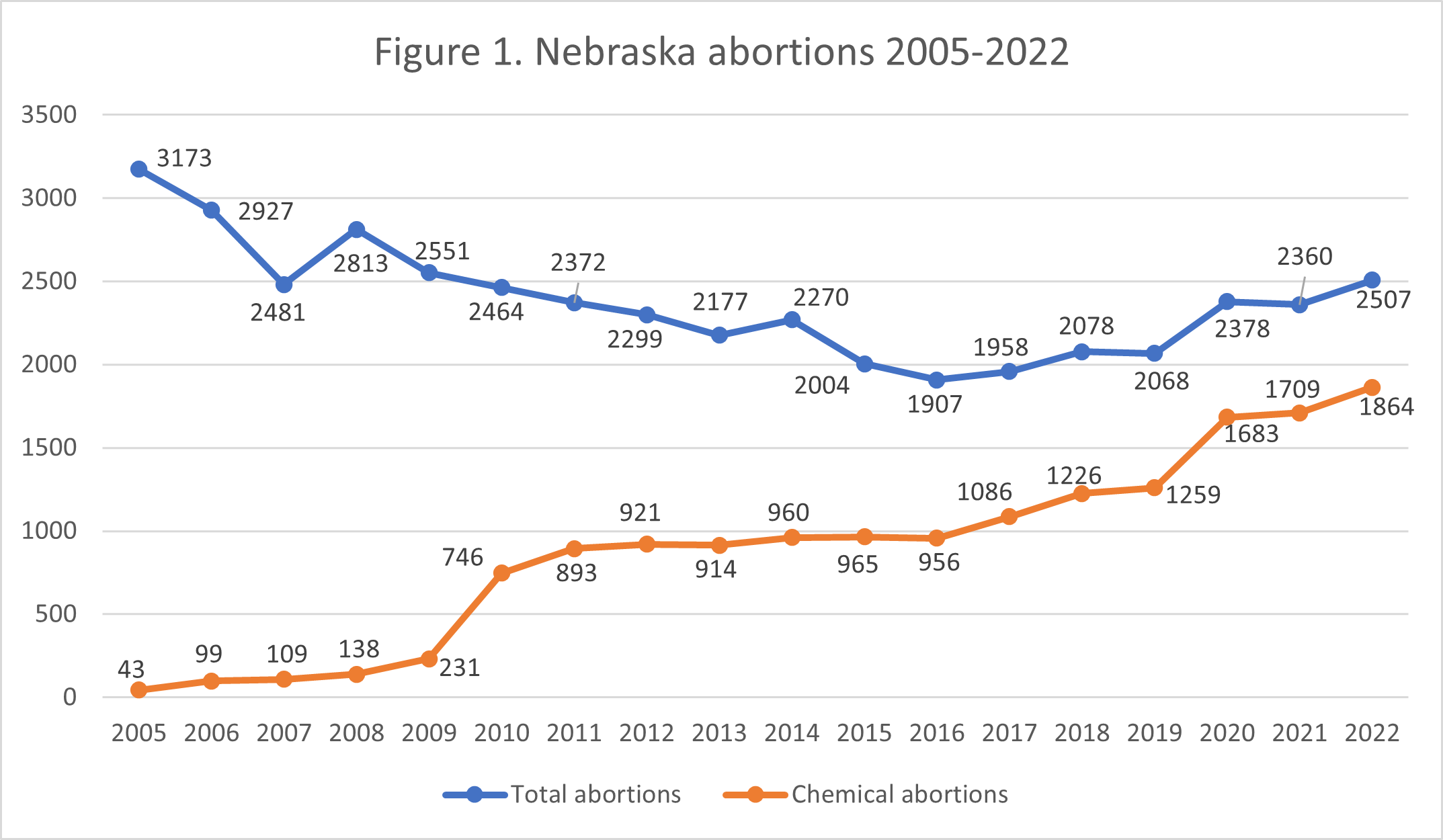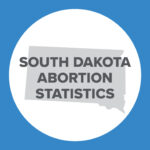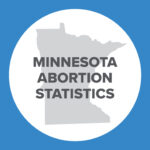Abortion Reporting: Nebraska (2022)
Nebraska’s 2022 abortion report was published in June 2023, showing that abortions had increased in the state from 2021.
Statistics and Changes in Nebraska Abortions, 2021-2022

The report does not include information on Planned Parenthood’s Nebraska abortion market share.
Abortion Totals and Trends
In 2022, there were 2,507 abortions reported in Nebraska, an increase of six percent from the 2,360 reported the previous year (Fig. 1). Chemical abortions jumped by nine percent from 1,709 in 2021 to 1,864 in 2022, making up 74 percent of all abortions in the state. Nebraska’s abortion rate increased by six percent to 6.6 abortions per 1,000 women of childbearing age, according to estimates by Charlotte Lozier Institute (CLI) (Fig. 2). As of August 2023, 16 states have released 2022 abortion statistics and 11 states reported that abortions increased from 2021.
State Report Summary
In 2022, 79 percent of the abortions reported in Nebraska were performed on state residents, while 21 percent were performed on women from other states, an increase from 12 percent in 2021. The number of women from Kansas, Missouri, and Texas increased 10, five, and 11-fold, respectively. The increase in Missouri and Texas women seeking abortions in Nebraska can be partially explained by prohibitions on abortion in those states (except to preserve the life or physical health of the mother) following the Dobbs decision in June 2022 and Texas’ pre-Dobbs enforcement of its heartbeat law. Nebraska’s abortion law did not immediately change following the Dobbs decision, and abortion was legal in Nebraska until 22 weeks gestation throughout 2022.
Eleven percent of Nebraska abortions were performed on girls younger than 20, and 60 percent were obtained by women in their twenties (34 percent by women ages 20 to 24, and 26 percent by women ages 25 to 29). Twenty-six percent of Nebraska abortions were performed on women in their thirties, and three percent on women ages 40 and older.
In 2022, 61 percent of the abortions were performed on white women, and 22 percent on black women. Three percent were on Native American women, and four percent were on Asian women. Two percent of the abortions were performed on women of other races. Race was not reported for eight percent of the abortions. CLI estimates that the black abortion rate of 25.1 abortions per 1,000 women ages 15 to 44 was more than five times the white abortion rate of 4.6.
Typically, Nebraska reports on the levels of educational attainment of women who obtained abortions in the state, but the 2022 report notes that the data provided was not entirely accurate, for the following reason: A large quantity of abortion forms submitted to the Nebraska Department of Health and Human Services (DHHS) indicated multiple levels of education attained and DHHS was unable to determine the woman’s level of educational attainment for about 1,000 abortions.
Sixty-six percent of the abortions were performed on women who had been pregnant before. Twenty-eight percent of the abortions were on women who had previously had an abortion, with 19 percent on women with one prior abortion and nine percent on women with more than one. Forty-three percent of women who obtained abortions in Nebraska had zero previous live births, while 21 percent had one previous live birth. Thirty-five percent had two or more previous live births, and there were 24 women whose number of previous live births were unknown. Eighty-three percent of the abortions were performed on unmarried women, and 15 percent were on married or separated women. Marital status was not reported for two percent.
Two dilation and evacuation (dismemberment) abortions and 82 dilation and extraction abortions (the procedure used in partial-birth abortion) occurred in 2022. Nebraska law prohibits performing dismemberment or partial-birth abortions on living unborn babies (unless it is necessary to save the life of the mother), although the procedures may be used after the babies have been killed. The majority of abortions reported in Nebraska (74 percent) were chemical. Twenty-two percent of the abortions were conducted via suction curettage. Seven sharp curettage abortions were performed, and one additional abortion was performed using another, unspecified method.
In 2022, abortion in Nebraska was permitted until 20 weeks post-fertilization (approximately 22 weeks of gestation). Thirty-two percent of Nebraska abortions were performed at six weeks of gestation or earlier. Thirty percent were performed between seven and eight weeks, and 18 percent occurred between nine and 10 weeks of gestation. Nine percent were performed between 11 and 12 weeks and seven percent were obtained between 13 and 15 weeks of gestation. Three percent were reported between 16 and 19 weeks. There were nine abortions at 20 weeks of gestation and 10 at 21 weeks.
The 2022 Nebraska report states that seven doctors performed abortions in the state in 2022. Unlike previous years, the report did not break down the number of abortions that each physician performed.
In 2022 Nebraska abortions occurred in three counties: Douglas County, where one of the state’s two Planned Parenthoods is located; Lancaster County, where the other Planned Parenthood is located; and Sarpy County where an abortion center once owned by infamous late-term abortion provider Leroy Carhart is located. Carhart passed away on April 28, 2023 but his center will remain open, according to family members. Twenty-eight percent of Nebraska abortions occurred in Douglas County, 15 percent in Lancaster County, and 57 percent in Sarpy County (an increase of 54 percent from 2021). The report does not indicate whether all abortions were performed in abortion centers or if some occurred in hospitals or doctor’s offices.
Women undergoing abortions in Nebraska are asked to share their reasons for seeking abortion, and each woman may provide multiple reasons. In 2022, 18 percent of the women declined to give a reason. Eleven percent of all women getting abortions were seeking an abortion due to contraceptive failure, and 66 percent did not use contraception.1 Three percent of all abortions were performed for socioeconomic reasons and four percent were performed due to the woman’s mental health. Fifty abortions (two percent) were performed due to physical health concerns. There were 12 abortions because the unborn baby was deemed to have an anomaly (0.5 percent), 15 to protect the woman’s life (0.6 percent), and six abortions due to sexual assault. Two abortions occurred because of an unspecified “emergency situation.”
Thirty-seven percent of the unborn babies killed by abortion were less than 60 millimeters long (approximately 2.4 inches), while three percent were 60 millimeters or longer. Sixty percent of the unborn babies could not be measured. Twelve percent of the babies weighed less than 100 grams, and three percent weighed 100 grams or more. Eighty-four percent could not be weighed.
In 2022, parental consent for abortion was obtained for 85 minors and not obtained for one. An exception to the parental consent requirement was made in 14 cases. There were two cases in which Nebraska’s informed consent requirements were waived due to an emergency situation. Five abortion-related complications were reported in 2022.2 There was one case each of a hemorrhage in which the woman lost more than 500cc of blood and one infection. There were two cases of retained products and one unspecified complication.
Legislative Changes
Nebraska abortion law did not change immediately following the United States Supreme Court’s decision to overturn Roe v. Wade in June 2022. However, in spring 2023, the Nebraska legislature passed LB 574 and the governor signed it into law on May 22, 2023. This legislation prohibits abortions from taking place in the state after 12 weeks gestation, excepting cases where the mother’s life or physical health is seriously endangered, or in cases of rape and incest. The legislature passed LB574 after failing by one vote to pass a heartbeat bill, LB 626, in April 2023.
State Ranking
In CLI’s 2016 evaluation of abortion reporting across the country, Nebraska reporting was ranked ninth best. As CLI has previously recommended, Nebraska could improve its abortion complication data collection and reporting. Nebraska could return to reporting the individual ages of women and girls, instead of grouping together all minor ages. Lastly, Nebraska could cross-tabulate its data so that the types of procedures are tabulated alongside the week of gestation at which they were performed.


- According to CLI analysis, Nebraska’s report mistakenly labels ‘Percent of Total Abortions’ numbers that instead reflect percentages of the total number of reasons given for having an abortion. CLI has corrected this mistake by calculating what percentage of total abortions each reason given actually is.
- Statistics on abortion complications reported here represent a minimal number of deaths and complications as this data is collected in a non-systematic and non-verifiable way. As such, this data cannot be used to calculate either an accurate abortion mortality rate or an accurate abortion complication rate for the state.
- National rates were calculated by Guttmacher Institute. Nebraska rates were calculated by CLI using the following formula: (total number of abortions performed in Nebraska ÷ number of resident women ages 15 to 44) x 1,000. Rates may differ slightly from previous CLI articles due to revised population estimates. Population estimates were obtained from the CDC WONDER database. Estimates for 2005-2009 are intercensal estimates of the July 1 resident population. Estimates for 2010-2019 are Vintage 2020 postcensal estimates of the July 1 resident population. Estimates for 2020-2022 are Vintage 2021 postcensal estimates of the July 1 resident population as the CDC has not yet released 2022 population estimates. Estimates were produced by the U.S. Census Bureau and the National Center for Health Statistics.



























